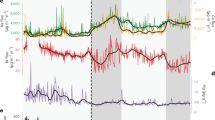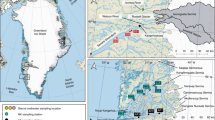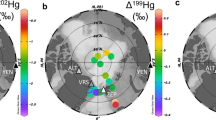Abstract
POLAR ice contains a valuable record of past atmospheric mercury deposition, which can provide information about both the natural biogeochemical cycling of this toxic trace metal and the impact of recent anthropogenic emissions. But existing studies of mercury in polar ice and snow cores1–5 suffer from sample contamination and inadequate analytical procedures. Here we report measurements of mercury concentrations spanning the past 34,000 years from the Dome C ice core, Antarctica, using the stringent trace-metal clean protocols developed by Patterson and co-workers6. Although this record does not extend into the industrial period, it provides an important baseline for future attempts to identify anthropogenic mercury in Antarctic ice and snow. We find that mercury concentrations were strikingly elevated during the last glacial maximum (18,000 years ago), when oceanic productivity may have been higher than it is today7. As oceanic mercury emission is correlated with productivity8,9, we suggest that this was the principal pre-industrial source of mercury to Antarctica; mercury concentrations in Antarctic ice might therefore serve as a palaeoproductivity indicator for the more distant past.
This is a preview of subscription content, access via your institution
Access options
Subscribe to this journal
Receive 51 print issues and online access
$199.00 per year
only $3.90 per issue
Buy this article
- Purchase on Springer Link
- Instant access to full article PDF
Prices may be subject to local taxes which are calculated during checkout
Similar content being viewed by others
References
Weiss, H. V., Koide, M. & Goldberg, E. D. Science 174, 692–694 (1971).
Appelqvist, H., Jensen, K. O., Sevel, T. & Hammer, C. Nature 273, 657–659 (1978).
Carr, R. A. & Wilkniss, P. E. Science 181, 843–844 (1973).
Herron, M. M. et al. in Isotopes and Impurities in Snow and Ice, 98–102 (Int. Assoc. Sci. Hydrol., 1977).
Murozumi, M., Nakamura, S. & Yoshida, Y. Mem. natn Inst. Polar Res. 7, 255–263 (1978).
Boutron, C. F. & Patterson, C. C. Nature 323, 222–225 (1986).
Sarnthein, M., Winn, K. & Zahn, R. in Abrupt Climatic Change (eds Berger, W. H. & Labeyrie, L D.) 311–337 (Reidel, Holland, 1987).
Kim, J. P. & Fitzgerald, W. F. Science 231, 1131–1133 (1986).
Mason, R. P. & Fitzgerald, W. F. Nature 347, 457–459 (1990).
Fitzgerald, W. F. in The Role of Air-Sea Exchange in Geochemical Cycling (ed. Buat-Ménard. P.) 363–408 (Reidel, Boston, 1986).
Fitzgerald, W. F. in Chemical Oceanography. Vol. 9 (eds Riley, J. P. & Chester, R.) 151–186 (Academic, London, 1989).
Lindqvist, O. Water Air Soil Poll. 55 (1991).
Nriagu, J. O. Nature 338, 47–49 (1989).
Nriagu, J. O. & Pacyna, J. M. Nature 333, 134–139 (1988).
Fitzgerald, W. F. & Clarkson, T. W. Envir. Health Pers. 96, 159–166 (1991).
Beiger, J. & Jernelöv, A. in The Biogeochemistry of Mercury in the Environment (ed. Nriagu, J.) 203–210 (Elsevier-North Holland. Amsterdam, 1979).
Jouzel, J. et al. Quat. Res. 3, 135–150 (1989).
Patterson, C. C. & Settle, D. M. Geochim. Cosmochim. Acta 51, 675–681 (1987).
Varekamp, J. C., & Buseck, P. R. Appl. Geochem. 1, 65–73 (1986).
Batifol, F., Boutron, C. F. & de Andelis, M. Nature 337, 544–546 (1989).
Taylor, S. R. Geochim. cosmochim. Acta 28, 1273–1285 (1964).
Gill, G. A. & Fitzgerald, W. F. Mar. Chem. 20, 227–243 (1987).
Leuenberger, M. & Siegenthaler, U. Nature 360, 449–451 (1992).
Prospero, J. M., Savoie, D. L., Saltzman, E. L. & Larsen, R. Nature 350, 221–223 (1991).
Cline, J. D. & Bates, T. S. Geophys. Res. Lett. 10, 949–952 (1983).
Saigne, C. & Legrand, M. Nature 330, 240–242 (1987).
Martin, J. H., Gordon, R. M. & Fitzwater, S. E. Nature 345, 156–158 (1990).
Petit, J. R., Briat, M. & Royer, A. Nature 293, 391–393 (1981).
Bloom, N. & Fitzgerald, W. F. Analyt. chim. Acta 208, 151–161 (1988).
Boutron, C. F., Patterson, C. C. & Bankov, N. I. Earth Planet. Sci. Lett. 102, 248–259 (1990).
Author information
Authors and Affiliations
Rights and permissions
About this article
Cite this article
Vandal, G., Fitzgerald, W., Boutron, C. et al. Variations in mercury deposition to Antarctica over the past 34,000 years. Nature 362, 621–623 (1993). https://doi.org/10.1038/362621a0
Received:
Accepted:
Issue Date:
DOI: https://doi.org/10.1038/362621a0
This article is cited by
-
Arctic mercury flux increased through the Last Glacial Termination with a warming climate
Nature Geoscience (2023)
-
A 15,400-year record of natural and anthropogenic input of mercury (Hg) in a sub-alpine lacustrine sediment succession from the western Nanling Mountains, South China
Environmental Science and Pollution Research (2020)
-
Effects of climate variability on mercury deposition during the Older Dryas and Younger Dryas in the Venezuelan Andes
Journal of Paleolimnology (2020)
-
Evidence of air-snow mercury exchange recorded in the snowpack at Dome Fuji, Antarctica
Geosciences Journal (2014)
-
A 17,300-year record of mercury accumulation in a pristine lake in southern Chile
Journal of Paleolimnology (2013)
Comments
By submitting a comment you agree to abide by our Terms and Community Guidelines. If you find something abusive or that does not comply with our terms or guidelines please flag it as inappropriate.



